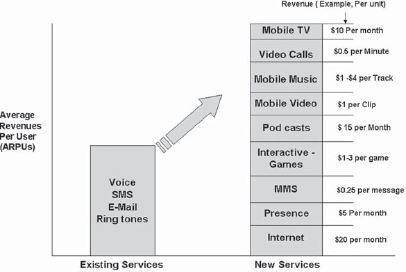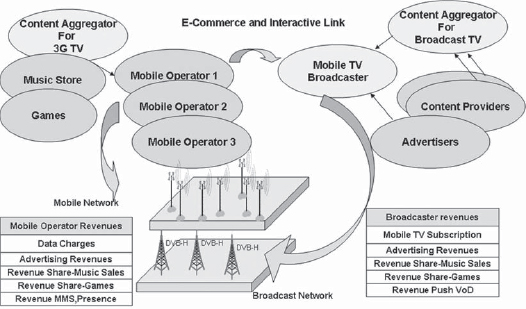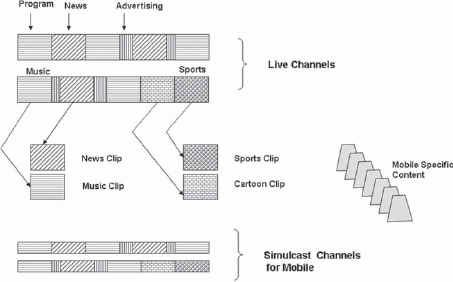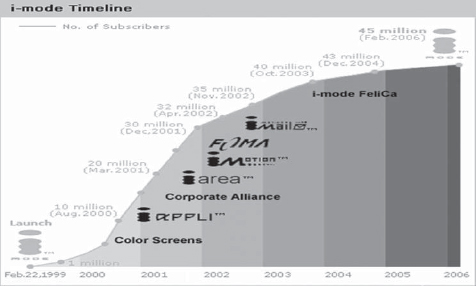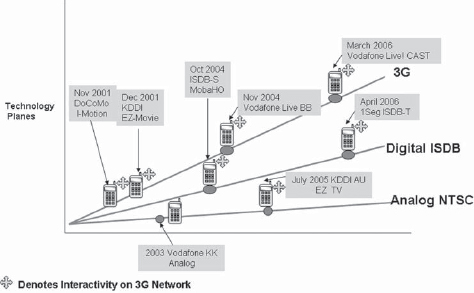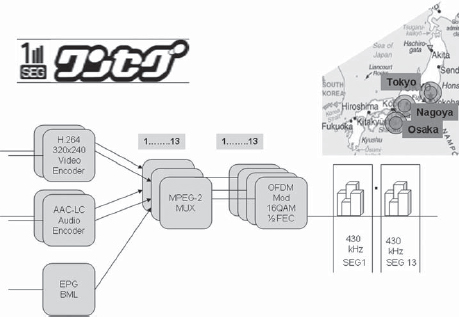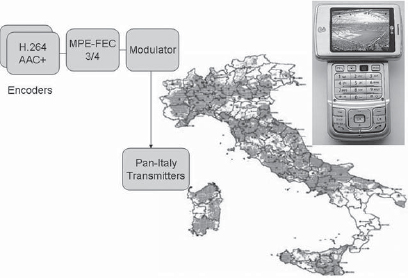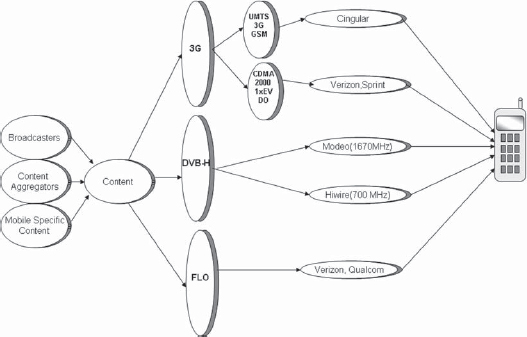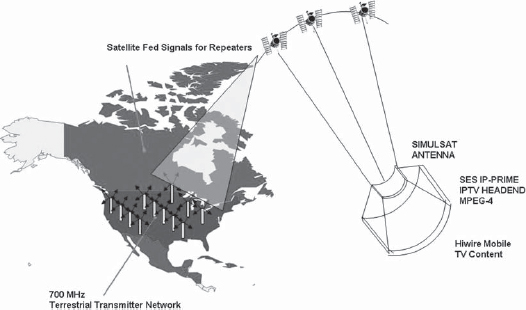14
MOBILE TV SERVICES AND MULTIMEDIA SERVICES WORLDWIDE
In this business, by the time you realize you are in trouble, it is too late to save yourself.
—Bill Gates
14.1.1 Mobile TV
The launch of mobile TV and mobile multimedia services in various countries across the globe is an important event as it embodies the fruition of plans that were the objectives of the 3G services in general.
To recap briefly the history of the launch of broadcast-mode mobile TV services, we begin in Korea with the S-DMB launched by TU Media and SK Telecom, making their debut in May and December 2005, respectively. Integrated Services Digital Broadcasting (ISDB)-T services followed in Japan in April 2006 and DAB-IP services were launched by BT Movio in the United Kingdom in June 2006. In the meantime over 25 trials had been conducted for DVB-H services in a number of countries in Asia and Europe, which led to the launch of the DVB-H service in Italy in June 2006 by Operator 3 and in October 2006 by Mediaset. In Germany T-DMB services were launched by MFD in June 2006 and the DVB-H trials went live with the FIFA World Cup 2006.
The momentum of new launches has been somewhat hampered by the licensing process and the allocation of spectrum, but the field has been set for full-fledged growth of these services through 2007, when most of the networks will find realization. A number of networks are now under active implementation in Europe, Asia, and the United States.
While Korea and Japan were early movers, with broadcast-based mobile TV services, the United States had a strong beginning with 3G network-based mobile TV services such as MobiTV and VCAST. Falling in the domain of 3G services, live TV services are available over the networks, which migrated to 3G, and the percentage of users covered by CDMA2000 or 1×EV-DO or 3G-UMTS networks is rising very fast, along with the growth of such services. Services such as MobiTV are available not only in the United States, but also now in many countries in South America such as Brazil and Mexico. MobiTV services are also available on WiMAX and Wi-Fi networks.
Since their launch mobile TV services have made strong headway in Japan and Korea, where the earliest offerings and the biggest installed bases were established. They are expected to grow strongly in the markets of the United States, Europe, and Asia based on both the 3G-based technologies and the broadcast-based services such as DVB-H. Functions such as video calls, media streaming, multimedia messaging, and video on demand now complement the smart phone features of personal information management, Internet browsing, mailing, document creation and viewing, and personal databanks. The revenue models of mobile operators are now strongly oriented toward providing multimedia services as a core activity.
14.1.2 Mobile Multimedia
A new revolution is now sweeping the cellular mobile industry that goes beyond the implementation of 3G or its successor technologies in the networks. The new paradigm is how to have mobile service platforms that can deliver advanced multimedia services such as location information, presence, multiplayer gaming, mobile TV, mobile music and videocasting, mobile-enabled Podcasting, and advanced MMS services, among others. Open Mobile Alliance, 3GPP, and other industry organizations are helping in the deployment of the services efficiently across many countries and regions in the world. As in the case of mobile TV, the industry, along with the upgradation of networks to 3G, also has to upgrade to new generation platforms for multimedia delivery. There is an awareness in the industry that the 3G infrastructure, which has been built with huge investments, also presents relatively unutilized networks, which await innovative multimedia applications.
The trends are being capitalized on by mobile virtual network operators (MVNOs), which are exclusively focused on the delivery of multimedia content and rich applications. Some of the MVNOs include ESPN, Disney, Helio, and AmpD.
14.2 APPROACH TO MOBILE TV NETWORKS
Mobile TV and multimedia services are important for mobile companies owing to the flat or declining average revenue per user curves generated from voice services alone. With over 2 billion users on the mobile networks, the new services provide an attractive revenue opportunity for the mobile operating as well as manufacturing companies. At the same time they are also attractive to the users owing to better reach for entertainment services, music stores, and storage of personal entertainment information. This is well demonstratedby the success of the Japanese 3G services with their focus on multimedia content. Japan, which had 40 million WCDMA customers by mid-2006, had clocked over $10 billion in wireless data revenues in the fist six months of 2006, against $5 billion for China with 400 million customers.
The new technologies now available for multimedia services are leading a shift from traditional mobile services to new multimedia services (Fig. 14-1).
Most of the mobile operators are now well focused on the mobile multimedia services delivered via mobile phones.
FIGURE 14-1 Building Revenues through Multimedia Services
14.2.1 SMS and MMS
SMS has been the most successful application as far as data revenues are concerned and constitutes over 70% of data revenues of operators who have not ventured into new mobile multimedia services. Even in the future SMS is expected to remain a strong revenue generator owing to its simplicity and high utility. On the other hand, messaging revenues constitute less than 30% of revenues of operators such as NTT DoCoMo Japan and mobile operators in Korea, where multimedia is a strong revenue driver. SMS messages not only are a medium of person-to-person communications but also bring interactivity to a number of applications such as mobile banking, office applications, and shopping. Bulk SMS gateways are used by companies to promote their products or service customers. SMS service revenues were estimated to be $70 billion by the Gartner Group in 2005.
MMS messages had their origin in an attempt to leverage the capabilities in the handsets equipped with cameras so that messages with pictures, videos, and presentations could be sent. The MMS messages also led to better use of the data network, as voluminous content is now transferred. As an example, in the United States, Sprint PCS was the first to introduce camera phones in 2002, which it followed with its picture mail and video mail service. By 2004, the network had logged over 100 million MMS messages.
14.2.2 FlashCasts
An example of new applications enabled by multimedia is a client server application called FlashCast, which uses a client on the mobile phone. Applications prepared in Macromedia Flash Lite can be downloaded on mobile phones and played to provide a rich look and feel. FlashCast services integrate with the media players and operating system on the phones (e.g., S60, BREW, Windows Mobile). FlashCast has a powerful scripting language, which leverages on the existing applications such as SMS and MMS and helps provide services that can be distinguished by quality and appeal. NTT DoCoMo launched the FlashCast Service in September 2005 under the name i-channel. Using this technology customers could receive five base channels for content such as news, weather, sports, entertainment, and astrology. The service was usable via the FOMA 902i series of handsets.
14.2.3 Mobile VoIP
The availability of high-speed Internet connectivity via 3G networks on the handsets has made it very convenient to place calls via VoIP. In order not to lose on these revenues operators such as Verizon, AT&T Wireless, and others offer VoIP services. VoIP services can also be used over Wi-Fi, W-LAN, or WiMAX networks.
14.2.4 Video Clips
Multicasting or on-demand transmission of video clips has been launched by many carriers to leverage on the capabilities of the data networks. Verizon’s V Cast service for example involved transmission of 3GPP2 video with QCIF resolution at 15 frames per second and was offered on its EV-DO network. V Cast music could be downloaded as WMA files. Each clip could be bought at $1 to $4 in addition to the monthly data charges of $15. Similarly, Cingular Video provides an on-demand streaming or downloadable service. Vodafone provides a Vodafone Live! music service for clip downloads in its networks in Europe and other countries.
14.2.5 Live TV
Live TV services are possible using broadcast- or multicast-based mobile TV networks. Most of the existing 3G networks, which provide unicast-based services, provide only streaming services for live TV or other content. While it is claimed that specially prepared content such as headline news, weather, music, or sports events are best suited for mobile TV, the users also have a special interest in live TV channels on mobiles. Mobile TV services using DMB, DVB-H, and other technologies are now available in a number of countries.
14.2.6 Video on Demand (VoD)
VoD is a well-established technology in pay-TV networks. Mobile VoD is the common method of providing video content to mobile TVs in 3G networks, which are based on unicast transmission. VoD can also be provided by mobile TV broadcast networks in a “push mode,” in which it is delivered to mobiles and the users can buy the rights to view such content. Mobile VoD expands the viewership base as it enables interested viewers to view programs while away from their TVs or PCs, i.e., in a mobile environment.
14.2.7 Video Calls
Video calling service as per 3G-324 M standards has been available from a number of operators. The service provides a new user experience and increased usage of network. An example of video calls is the Vodafone Live! Video calling service can be initiated on the handset by pressing the “video call” button instead of the “voice call” button.
14.2.8 Games
Mobile gaming services provide an attractive revenue opportunity for operators. The games can be single player or multiplayer games and can have varying amounts of complexity and graphics. The games have been found to generate a lot of data traffic arising out of interactivity as well as downloading of the games themselves. In fact messaging, chat, music, and games go together in “buddy groups” and have high appeal for youngsters, which constitute the major users. Most of the single-player games have been derived from the video gaming industry, such as Play Station 2, XBOX, Nintendo, and Gameboy and are based on the use of Java or BREW. Mobile multiplayer games on the other hand constitute a new initiative. Specialized mobile gaming devices have also been introduced by the handset manufacturers to overcome the limitations of the normal handset for playing games. The Nokia N-Gage is an example of such a mobile device. The Mobile Games Interoperability Forum under the Open Mobile Alliance (OMA) is creating standards for mobile games. Almost all operators today offer mobile gaming services. As an example, in August 2005, Singtel introduced mobile multiplayer gaming services based on a product offering from Exit games. Exit Games Neutron multiplayer games have also been launched widely in Europe and the United States.
14.2.9 Audio Downloads
Audio downloads are one of the most important services for mobile operators as they increase revenue opportunities through data usage and revenue share from content providers. It also promotes the sale of high-end handsets with stereo audio and large storage. It is therefore not surprising that the service is high on the list of mobile operators, most of whom have launched “music store” types of services. In the United States Sprint Nextel launched a mobile audio download service using its Power Vision network. Users can download music from the music store online. In the United Kingdom, Orange has been providing audio download services through the Groove music store. Apple’s i-Tunes music store can be accessed directly from mobile phones using the Rokr handset developed by Motorola.
14.2.10 Podcasting
Podcasts are recorded programs available on the Internet. They usually comprise multimedia files including video and audio. Audio is usually recorded in MP3 format commonly used on the Internet for audio. It can be downloaded into mobile players (such as an iPod) and enjoyed on the go. With the availability of the Internet on mobile phones, the need to transfer music or multimedia files (from the PC after downloading from the Internet) no longer exists. Podcasts can be received by mobile phones directly (using programs called Podcatchers) and played using the media players. Mobile clients are now available, which can display the list of available Podcasts and allow the user to download or receive streaming content. Mobile operators derive revenues from the data usage of the network. As the Podcasts are not recorded in mobile-optimized content (e.g., AAC+ or WMA) they can involve large file transfers for an average program durations of 15–60 min, which can be in the range of 7–30 Mbytes). The prime product the carriers prefer to offer for music is the “mobile music” service with its built-in DRM. However, the users have a clear preference for noncontent-protected music or programs that are also available on the net as Podcasts. Syndicated Podcasts, for which the users need to subscribe to the service, are now being promoted to benefit from both the syndication and the usage-based revenues.
In the United States, Alltel has launched a Podcasting service, “Alltel Racing” (www.allelracingpodcast.com), which is rich in video and audio content relating to races. The Podcasts are done using an RSS feed (an XML-based format called Really Simple Syndication). Podcasts can be received using Web-based Podcatchers, desktop-based devices, or mobile-specific Podcatchers. Some of the mobile-based Podcatchers include VoiceIndigo and Mobilecast. Users, however, need not depend on the carrier-provided Podcasts. Podcasts can also be “mobilized” using the user’s Internet Web site and free software available with Podcatchers such as VoiceIndigo. The numbers of Podcast sites being enabled for the mobile are now steadily increasing.
14.2.11 Presence
Presence and location-awareness services are an important value addition to the mobile phones. The caller, for example, can be aware of whether the person he wishes to call is at an important engagement or otherwise busy by using the “presence feature.” Presence-enabled mobile services can also be used in a business environment to manage a mobile workforce. Instant messaging services are derived from the presence capability of the mobile platforms. Instant messaging and presence services (IMPS) are being provided by various mobile operators based on the OMA standards (OMA IMPS 1.2 or higher versions).
Location awareness can point out the exact location of the user (within a few hundred meters) to a service provider for emergency services. There are a number of auxiliary services that can be derived from the location awareness services such as proximity alerts, personalized services, and logistic services.
As an example, NTT DoCoMo, for its FOMA network, developed instant messaging and presence services that could be used by downloading the i-appli application for registering and displaying presence. Orange France launched instant messaging and presence services in July 2005. This enabled the users to send and receive presence information within the Orange network. These operators signed up to interconnect their instant messaging networks during 3GSM 2006, signaling that the service will have wide support in Europe, Asia, and other regions.
14.3 CONTENT MODELS OF COMMERCIAL OPERATORS
14.3.1 Content Aggregation
While there are a number of multimedia services that can be used to derive revenues from the multimedia networks, mobile operators are not themselves adept in all the technologies based on continuing developments and generation of rich content.
This has led to the operators entering partnerships for receiving aggregated content as well as mobile-specific applications, games, music stores, interactivity, and commerce platforms. Mobile operators are then free to focus on delivery while the content and commerce partners provide industry-competitive rich content. In the 3G arena, where the mobile operators are themselves responsible for broadcasting of content, content aggregators such as MobiTV provide aggregated content to the operators. Where the mobile TV or multimedia broadcasts are carried out by broadcasters using DVB-H, 3G, or DMB technologies, we see at the first level the partnerships between mobile TV broadcasters and mobile operators for interactivity and revenue generation.
FIGURE 14-2 Revenue Models of Mobile TV Operators
An example is Sky-by Mobile service in the United Kingdom, in which British Sky Broadcasting (BskyB) has joined with a number of mobile operators (such as Vodafone and Orange 3) to enable mobile phones to receive Sky channels. In Italy Mediaset, primarily a media company, has acquired frequencies that enable it to launch a DVB-H multiplex for mobile TV. Mediaset has joined with mobile operators so that mobile TV services can be delivered in conjunction with their networks. This requires tie ups for handsets, interactive links, and broadcasters such as LA7, MTV, SkyTG24, and SkyMETEO24. Such arrangements are also beneficial for mobile operators, which would be under threat from dual-mode handsets that can receive DVB-H and digital terrestrial transmissions (DTT) (Fig. 14-2).
14.3.2 Mobile TV-Specific Content
While mobile TV is still in its early years, its usage pattern and results of early trials suggest that certain specific types of content are most suited to the small screen and the short duration for which the viewers are likely to view the content (Fig. 14-3).
FIGURE 14-3 Mobile Content Options
Examples of some of the mobile TV-specific content include:
• GoTV video-on-demand channels in the United States,
• ITV programs produced as videos for Operator 3,
• CNBC Mobile shows produced for mobile TV, and
• Disney Mobile Cartoons.
Content and services on mobile networks are covered in greater depth in Chap. 15.
14.4.1 Japan
Japan has had the distinction of having the first 3G network-based i-mode and FOMA services since the year 2001. The earliest mobile clip and animated pictures download service was introduced by NTT DoCoMo with the launch of the i-motion service in November 2001.
FIGURE 14-4 NTT DoCoMo i-mode Services (Courtesy of NTT DoCoMo)
The service featured 3GPP encoded content (MPEG-4 video and AMR audio) in the 2001 implementation (Fig. 14-4).
Subsequently the users of FOMA services have been able to download or view streaming video as part of a broad range of multimedia services offered by the mobile network.
In 2003, Vodafone KK introduced handsets with analog tuners that could receive NTSC standard programs. Subsequently the service was enhanced to be a two-way interactive service with the launch of EZ-TV by KDDI. The EZ-TV service involved analog reception on the handset coupled with interactive services such as downloading of background music. The programs on which such interactive services could be used were marked as “Chaku-Uta full content.” The handsets that could be used with the service included W32SA (Sanyo Electric Co., Ltd.), W31CA (Casio Computer Co., Ltd.), W31T (Toshiba Corp.), A5511T (Toshiba Corp.), and A5512CA (Casio Computer Co., Ltd.). One of the handset versions was with an FM transmitter enabling the songs downloaded to be played on FM radios (such as car radios). The EZ-TV also included capability using the KDDI mobile network to access the Web sites of programmers, download EPG information, and also purchase the media tracks online.
For broadcasting of TV programs Japan has adopted the Integrated Services Digital Broadcasting standards. As the name suggests, the service permits the transmission of a mix of various services on the same transmit carrier with flexible allocation of bandwidth based on requirements. The ISDB has the ISDB-S standard (for satellite transmissions), ISDB-T for digital transmissions, and ISDB-C for transmissions on cable.
The ISDB standard provides for 13 segments in a single carrier slot of 6 MHz and hence each segment has approximately 430 kHz of usable bandwidth. The segmentation is done by selecting frequency blocks from the OFDM modulator.
The first transmissions for mobile TV using ISDB-S began in October 2004 as the MobaHO consumer satellite broadcasting service. The service featured MPEG-4 version 1 simple profile video coding and AAC (LC) audio coding. The resolution supported was 320 × 240 (QVGA) and the bit rates were 384 kbps. Audio service was coded at 144 kbps. The initial bouquet was 8 video and 30 audio channels (with option for additional premium video channels). The system was protected by MULTI2 Cipher. The coverage included all of Japan.
Mobile TV services using terrestrial transmission began in Japan using one of the segments (and hence sometimes called 1SEG broadcasting) under the ISDB standard. ISDB-T services using 1SEG broadcasting were launched in Japan in April 2006 (Fig. 14-5).
The 1SEG broadcasting services were started in April 2006 as a free public broadcasting service in Tokyo, Osaka, and Nagoya featuring 34 channels. Being a pure broadcast service it is independent of the mobile operators (all of whom can make arrangements with the broadcasters to have interactive features via their 3G networks).
Data broadcasting is another feature of the service that is being supported by all broadcasters. Data broadcasting has information such as weather, sports, Anytime News, and electronic service guides. The data broadcast uses Broadcast Markup Language, which features broadcast over terrestrial broadcast or 3G networks. A number of handsets are now available, such as KDDI Sanyo W33SA and KDDI Hitachi W41A. The transmissions can also be received on PDAs and car-mountable receivers.
FIGURE 14-5 Mobile TV Services in Japan
At the same time the 3G operators have kept the drive for new 3G-based multimedia services in Japan. Vodafone introduced Vodafone Live! for multimedia broadcasts in September 2004 and Vodafone Live! V CAST video streaming services in March 2006 (Fig. 14-6).
14.4.2 The United Kingdom
The United Kingdom offers an interesting example in the mobile TV scenario because while almost all broadcasters are live on 3G platforms, one of the first offerings of DAB-IP technology-based broadcast TV has now been launched. BT Movio, the mobile TV service offered by BT and virtual mobile operator Virgin Mobile, operates in the UK DAB band. The October 2006 launch included the channels BBC1, ITV1, channel 4, and E4 Live and in addition a number of digital audio broadcasts. The service was launched using the Virgin Mobile Lobster 700 TV phone (by HTC). The handset is a smart phone with a Windows Mobile operating system and 3G support. Interactivity is provided through a “red button” support. The broadcast services are accompanied by 7 days EPG. As the broadcasts are received using the DAB, they are independent of the mobile operator at present. As the name DAB-IP suggests, the broadcasting system is based on the use of IP as the transmission technology. BT Movio uses Windows Media 9 codecs and players on the handsets for multimedia delivery.
FIGURE 14-6 1SEG Broadcasting in Japan
The broadcast-based mobile TV scene in the United Kingdom has been partly influenced by the availability of spectrum. Owing to the digitalization of the terrestrial broadcast network spectrum has not been available for the DVB-H services in the United Kingdom so far.
In the 3G space, the United Kingdom has five operators (Vodafone, Orange, 3, T-Mobile, and O2) and an MVNO, Virgin Mobile. 3G operators such as Orange, 3 (Hutchison), and Vodafone (in cooperation with BskyB) have begun offering a number of BskyB channels.
14.4.3 Germany
Mobile TV services were launched in Germany coinciding with the FIFA World Cup in June 2006 and were based on two technologies, i.e., T-DMB and DVB-H. T-DMB service was launched by broadcast operator MFD in cooperation with mobile operator Debitel. The initial launch featured five cities (i.e., Berlin, Frankfurt, Munich, Cologne, and Stuttgart) and four channels of TV. The subscription was 10 euros per month.
The DVB-H service was launched in the form of trials by four mobile operators, T-Mobile, Vodafone, O2, and e-Plus.
14.4.4 Italy
3 Italia has the distinction of having launched the world’s first commercial DVB-H network on the June 5, 2006. The service was launched using a new DVB-H network created by the company across Italy in the UHF band with coverage of 75% of the population (2000 towns and cities). The service was branded as Walk-TV. The initial launch comprised 9 channels, which are slated to grow to 40 by 2008. At the time of the launch the mobile TV services were offered at 3 euros per day or 29 euros per month. Alternatively packaged voice call (1 hour per day) and mobile TV were offered at 49 euros per month. The initial channels included RAI1, Canale 5, and Sky TG24. 3 Italia is producing La3 Live, a channel specifically designed for mobile TV (Fig. 14-7).
Table 14-1 gives the main features of the service.
14.4.5 The Netherlands
The Netherlands is one of the few European countries where analog TV transmissions are being phased out by the end of 2006. DVB-T-based terrestrial transmissions are being sent by KPN even though it is primarily a Telecom operator.
The major operators offering 3G services in The Netherlands are Vodafone, Orange, KPN, and T-Mobile. KPN introduced video telephony in October 2004 using its 3G UMTS network and Sony’s Z1010 phone. Mobile TV (i-mode) services are being offered by KPN using its 3G network.
DVH-H trials were also carried out by KPN (along with Nokia, Nozema Services (a broadcasting company), and Digitenne as partners).
FIGURE 14-7 3 Italia DVB-H Network
3 Italia DVB-H Service
Service standard: nonhierarchical DVB-H CBMS with DVB-IP datacast specifications |
Transmitter network |
Transmission parameters |
|
Handsets: LG U900, Samsung P910 |
|
Content protection |
|
Interactivity: FastESG from EXPWAY |
|
Mobile network: 3 Italia’s 3G UMTS network, 6 million users in March 2006 |
|
Broadcasting partner: Mediaset |
The DVB-T platform of KPN was used for this purpose. The Nokia 7710 with a DVB-H receiver was used for the trials. The trial included an interactive channel, “Portable Hollywood,” which included interactive online quizzes on Hollywood-based shows and celebrities.
The United States presents an interesting example of mobile TV, as it is potentially the largest launch site for services using the MediaFLO technology. It is also interesting owing to the innovative launches of channels exclusively meant for mobile, such as ROKtv and FreeBe TV (free television on mobiles). Many of the channels can be viewed by using the WAP browser to access the content and the RealPlayer for viewing it. This means that they are not dependent on the mobile TV network, rather any 3G network with an Internet address can be used to access the services.
The United States has Cingular and T-Mobile as the major 3G operators using GSM-evolved technologies (GSM/GPRS or 3G-UMTS), and Verizon Wireless, Sprint, and Alltel are the major CDMA2000 and 1×EV-DO operators. Almost all the operators (except T-Mobile USA) are now providing multicasting of TV channels (such as Verizon’s V CAST) meant for mobiles and content from standalone broadcasters as well as content aggregators such as MobiTV.
The U.S. mobile TV offerings have been characterized by variations from some of the global standards for technologies such as DVB-H, for which the operator Modeo is adapting the Windows Media technology codecs instead of H.264 and Microsoft proprietary DRM as opposed to OMA DRM 2.0.
At the same time, Qualcomm is offering its MediaFLO technology to CDMA operators. Verizon Wireless has already announced mobile TV services using FLO technology. This implies that the market will have a mix of technologies in the foreseeable future. The DVB-H services of Modeo in the 1600- to 1675-MHz band will compete with the CDMA operators’ offerings of FLO technology (700-MHz band) as well as the 3G networks (with HSDPA and 1×EV-DO) (Fig. 14-8).
Mobile TV using DVB-H technologies is also being introduced progressively as new networks without any integration with the existing ATSC DVB networks, as is the case using DVB-H and DVB-T in Europe. Modeo is introducing its DVB-H network using the L-band at 1670MHz, while Hiwire is planning to use the 700-MHz band. Hiwire is using SES Americon’s IP-PRIME IPTV broadcast center and the content will be broadcast using MPEG-4 to the SES satellite distribution network.
Ground-based transmitters will then deliver the content terrestrially using 700 MHz of spectrum (Fig. 14-9).
FIGURE 14-8 Mobile TV Services in the United States
14.4.7 Hong Kong
Mobile TV services have been launched by the operator CSL in Hong Kong in March 2006 on the 3G network. The service is based on the Golden Dynamic’s “VOIR Portal” and follows the 3GPP standard 3G-324 M. This provides a circuit-switched connection delivering consistent quality video without any delay in switching of channels. CSL is a wholly owned subsidiary of Telstra and it is being merged with New World PCS and will be the largest mobile operator in Hong Kong.
14.4.8 China
China presents an interesting case for many reasons. First of all the number of mobile subscribers in China is the highest in any country in the world (over 400 million) and therefore it presents the highest market opportunities for any new technologies. Second, only a few companies (no more than three) control the majority of the market. In fact China Mobile at 290 million subscribers by the third quarter 2006 virtually had control of the market. Third, despite the huge growth the 3G services are yet to be introduced, though the country has the distinction of being the host of the 2008 Olympics. Finally, China has been inclined toward the use of its own standards for terrestrial television as well as mobile TV. This makes the Chinese market ripe for the most rapid developments in the coming years.
FIGURE 14-9 A Visualization of the Hiwire DVB-H Services in the United States
14.4.9 India
India, with its base of over 100 million mobile users in 2006 and growing at over 80% per year, is a prime candidate for the attention of mobile TV and multimedia service providers. At present, owing to the ongoing spectrum allocation process, the mobile operators do not provide 3G-UMTS services. However, Reliance Infocom, with its CDMA2000 network, launched “near live” mobile TV channels in January 2006. The initial launch had included two channels, i.e., NDTV and Aaj Tak, both news channels.
In the field of terrestrial broadcasting Doordarshan, a state-owned broadcaster, is the sole operator as DTT has not yet been opened up. Nokia and the state-owned Doordarshan have already conducted a trial of DVB-H technology with favorable results and the service launch is being planned.
Mobile multimedia networks provide new revenue opportunities for mobile operators, broadcasters, content providers, and e-commerce platform operators. The large base of mobile phones, exceeding 2 billion, with high-capacity networks for delivery and personalized delivery, present opportunities that cannot be ignored. Mobile TV and multimedia delivery platforms have been rolling out innovative multimedia and mobile TV services based on varied technologies such as 3G, DVB-H, DVB-T, and ISDB. The coming years will lead to greater standardization in the industry.

